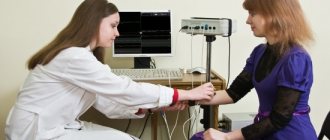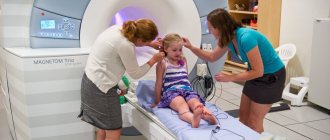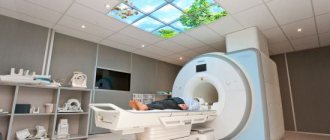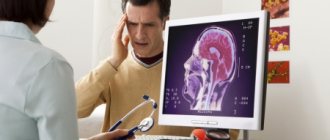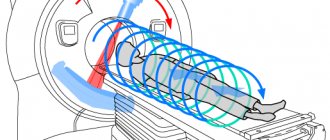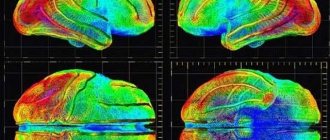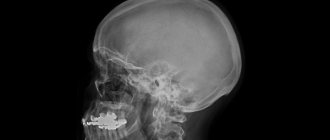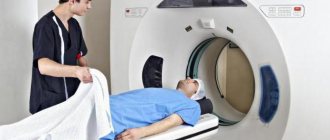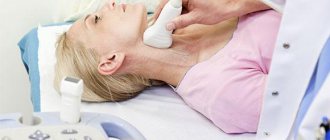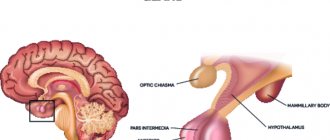Electroneuromyography (ENMG) is a method for studying peripheral nerve fibers and muscles, which helps determine the location and cause of motor dysfunction. The method is widely used in neurology and surgery, because allows you to estimate the number of nerve impulses in an area of the body and the speed of their passage through the fibers, as well as obtain the exact value of the muscle response (M-response) to the stimulus.
Electroneuromyography at the St. Petersburg Neurology Center
Electroneuromyography is one of the methods for studying the neuromuscular system, which is carried out by fixing electrodes and subsequent analysis of the bioelectrical activity of the peripheral nervous system and muscles.
When the functions of the peripheral nervous system are impaired, a person feels various symptoms and signals that the body gives. As is correct, the patient begins to complain of constant or episodic muscle weakness, numbness of the arms and legs, a feeling of “pins and needles” appears in them, and various pain sensations are possible. These symptoms give the neurologist reason to suspect the presence of a particular problem. At the Zhulev Neurology Center, you can do 2 types of electroneuromyographic examination ENMG:
- Stimulation (skin electrodes are used) - study of the effectiveness of the passage of nerve impulses along peripheral nerve fibers.
- Needle – needle-type electrodes are inserted into the desired muscles. This is a painless method, the sensation is no stronger than a mosquito bite.
Electroneuromyography helps clarify the diagnosis. This examination provides accurate information about the level, extent and nature of damage to nerve fibers.
Diagnostic criteria for the electromyography procedure:
- The doctor should evaluate how sensitive the muscles are. To do this, a small current discharge is applied to a specific muscle group and the response is assessed. If it is not there, then we can talk about a violation of muscle functionality.
- It is necessary to determine the neuromuscular interaction. If the fibers do not respond to current pulses or involuntary contractions occur, this indicates a violation of neuromuscular transmission.
- A neurologist conducts a study of the peripheral nervous system. To do this, the speed of impulse transmission along the peripheral nerve is measured. The reaction should not be slow, otherwise we are dealing with pathology.
Such diagnostics turn out to be very effective for determining spinal osteochondrosis with radicular syndromes (radiculitis), mono- and polyneuropathies in a patient. ENMG makes it possible to objectively assess limb injuries in which nerve trunks and endings are affected.
The essence of the method
Muscle movement occurs as follows: the impulse originates in the brain in the centers that are responsible for motor activity. Then the signal goes through neurons, nerve pathways, plexuses, reaches the muscles and, thanks to special synapses, passes from electrical to mechanical form - the muscle contracts.
In the presence of pathology at the level of nerves, nerve pathways, synapses, the functionality of the muscle is impaired: increased fatigue, involuntary contraction, slow relaxation, and lack of movement may be observed.
During ENMG, the device produces an impulse and checks the response of the muscle fiber to the signal, which allows you to determine the following:
- The ability of a muscle to contract in response to a stimulus.
- The quantity and quality of impulse transmission along nerve fibers.
- Impulse conduction speed.
- Localization of nerve damage, if present.
Myography will help determine the lesion at one of 8 levels in the motor pathway: suprasegmental, prohornal, radicular, at the level of the plexus, nerve column, terminal nerve branches, synapses, myofibers.
No other diagnostic will give a complete picture of the condition of the axon. ENMG allows the doctor to find out where the problem is.
Diagnostics using ENMG examination
The essence of the study is the stimulation of sensory and motor nerve fibers at various levels with microcurrents, which makes it possible to accurately determine the nature of the pathologies that have arisen. It falls into the category of harmless diagnostic procedures, but during its implementation, unpleasant sensations may appear, which are compensated by the significant therapeutic effect obtained as a result of nerve stimulation.
ENMG analysis is characterized by a high degree of information content, which greatly facilitates the neurologist to make an accurate diagnosis and choose the right treatment path, achieving a speedy recovery for the patient.
In some cases, needle electromyography (EMG) is additionally performed. A thin needle electrode is inserted into the muscle and records the activity of the muscle fibers.
How to prepare yourself
Electroneuromyography does not require special preparatory measures. But the patient must remember that the determination of the result is influenced by medications that affect the central nervous system; drinking sweet cola, strong tea, and coffee drinks should also be avoided before the diagnostic procedure. Stop taking medications a couple of days, and drinks that increase overall tone ─ 3-4 hours before the start of diagnostic procedures. Only if these conditions are met, electroneuromyography will show reliable information.
What diseases will the result of electroneuromyography show?
During an ENMG session, an electrical impulse is given to individual nerves, the response of the nerve or muscle is recorded, and based on the analysis of the response parameters, conclusions are drawn about the patient’s health status.
Using the ENMG procedure of the upper and lower extremities, you can identify:
- myopathy;
- radiculitis
- spinal amyotrophy;
- amyotrophic lateral sclerosis;
- myotonic syndrome;
- myasthenia gravis;
- neuropathy (of occupational, infectious-inflammatory or toxic origin);
- traumatic injuries;
- myotonia;
- diabetic polyneuropathy;
- toxic polyneuropathy
- polyneuropathy due to hypothyroidism
- polymyositis;
- polyradiculoneuritis;
- syringomyelia.
The procedure will help to quickly identify these pathologies and make it possible to take action faster. Early diagnosis is always half the success in the fight against disease.
How to diagnose
Electroneuromyography lasts from half an hour to an hour. There is a dependence on the type of examination and how extensive it is.
The patient should lie down or half sit. With a superficial examination there is no pain. It manifests itself slightly during needle and stimulation type examinations.
The doctor determines the location where the electrodes are attached. They are wiped with a solution that has a disinfectant effect, and smeared with a specific gel. When electroneuromyography is completed, the patient may feel some muscle weakness.
How much does it cost to do ENMG in St. Petersburg - price from 2,500 rubles
Please note that this proposal does not constitute an offer. Final prices depend on the availability of additional procedures and can be clarified by calling the clinic +7 (812) 935-60-12 or directly from the doctor.
| Services list | Price |
| Electroneuromyography stimulation (ENMG) one area | 2500 rub. |
| Electroneuromyography stimulation (ENMG) two areas | 4000 rub. |
| Electroneuromyography stimulation (ENMG) and needle (EMG) one area | 4000 rub. |
| Electroneuromyography stimulation (ENMG) and needle (EMG) two areas | 6000 rub. |
Contraindications
There are no absolute contraindications to electroneuromyography.
Relative contraindications to stimulation ENMG include the only disease – epilepsy. There are more contraindications for needle ENMG.
These include:
- pathologies of the blood coagulation system;
- inflammatory skin diseases located in the area of the proposed examination;
- systemic infections;
- acquired immunodeficiency syndrome;
- a thick layer of subcutaneous fat in the patient, above the muscles at the examination site, as this will obviously distort the result;
- mental disorders.
Who needs to sign up for an ENMG study?
Indications for such an examination are determined by the attending physician. The most common of them include the presence in patients of tunnel syndromes and neuropathies, radiculopathy, and plexopathy of various origins. This examination also helps with diabetes mellitus; it helps to identify polyneuropathy of the lower and upper extremities. ENMG examination is often prescribed for suspected amyotrophic lateral sclerosis, motor neuron disease, and myopathies of various origins.
You need to undergo electromyography if you begin to feel:
- weakness in the muscles of the arms or legs;
- heaviness in the legs;
- pain when raising your arms;
- numbness in fingers or toes;
- slow reflexes;
- periodic seizures;
- rapid onset of fatigue with light loads;
- tingling in muscles;
- swelling (usually affects the legs);
- muscle atrophy;
- muscle pain during exercise:
- muscular dystonia.
Indications for ENMG
There are quite a lot of diseases that require ENMG to be detected. In some cases, it may be sufficient to do only an EMG, or neuromyography will provide the necessary information. However, complex research is most often carried out. As a rule, myography of the legs is prescribed for diagnosis:
- various forms of polyneuropathy;
- various damage to nerve endings in the lower extremities;
- back injuries;
- various osteochondrosis;
- peripheral neuropathy;
- various neurites.
Condition of the nerves in the lower extremities
High-quality myography makes it possible to accurately diagnose not only diseases of the lower extremities; EMG is also quite successfully used to examine other parts of the body. When examining the lower extremities, myography provides high accuracy detection of various injuries and inflammations. The places where compression of the nerves in the legs have occurred are almost unmistakably localized. Additionally, it is possible to determine the presence of a process of restoration of nerve tissue and the need to take medications to ensure this process. Neuromyography during its implementation requires the application of cutaneous electrodes to the points of the skin to which the nerve fibers are closest, and not just to the disturbing muscle.
Myography has practically no contraindications.
But it is better not to perform a needle test in people with diagnosed immune disorders. Of course, the procedure will not affect the patient’s condition in any way. But medical staff run the risk of getting infected.
How is electroneuromyography performed by a neurologist?
The electromyography examination consists of the following stages:
- analytical summary of the examination results and drawing up a written report.
- if necessary, determine the type and degree of damage to muscle tissue by the pathological process using a needle electrode;
- hardware assessment of the function of sensory and motor fibers of the peripheral nervous system
The recorded data is then processed to produce a graphical curve resembling an electrocardiogram. The shape of the lines recorded during the session depends on the amount of working muscle tissue and the difference between the speeds of signal transmission along the nerve.
The conclusion should contain information about the location, degree and type of damage to elements of the peripheral nervous system if it is detected.
Preparation for the procedure
Electromyographic examination does not require special medical preparation. However, it should be taken into account that the accuracy of the analysis depends on the tightness of the electrodes to the skin (with cutaneous myography), deviations from the normal thickness of the fat layer, medication use and other factors.
Immediately before the study, the following rules must be observed:
- for at least one day before the examination, do not take muscle relaxants, anticholinergics and other medications that affect muscle tissue and peripheral nerves (with the permission of the attending physician);
- on the day of myography, do not drink caffeine-containing drinks (coffee, energy drinks, etc.) and chocolate;
- stop eating 4–5 hours before the test;
- inform the diagnostician about taking medications that reduce blood clotting, as well as about chronic infectious and non-infectious pathologies (including mental ones).
When prescribing a procedure, you must consult with the doctor conducting the study. If there are contraindications and factors that may affect the accuracy of the results, treatment, weight loss, temporary withdrawal of medications and other measures may be recommended.
Interpretation of the results of the ENMG examination
In order to correctly make a diagnosis based on an examination, you must have high qualifications in this field. Further prescriptions and the course of treatment will depend on the correctness of the doctor’s conclusions. Therefore, you should trust such diagnostics only to experienced neurologists in a specialized neurological clinic. After the session is completed, the data is displayed on the monitor and printed on paper.
Parameters based on which a specialist from the Neurology Center draws conclusions:
- Speed of impulse conduction.
- Amplitude of muscle activity.
- The ability of nerve fibers to conduct impulses.
- Uncontrolled contractions of muscle fibers.
About decryption
The results obtained, when electroneuromyography has already been performed, are interpreted only by an experienced specialist. From these data, the doctor sees the reaction of nerve fibers from the signals affecting them. Then the data is compared with normal values, all possible deviations are identified, and the doctor determines the final diagnosis, on the basis of which treatment measures are carried out.
Where to undergo the ENMG procedure inexpensively
We invite you to undergo an examination at our medical clinic in the center of St. Petersburg, not far from the square. Uprisings. One of the advantages of undergoing ENMG in our center is that the diagnosis will be carried out by an experienced neurologist, professor, who will be able to provide advice on any questions that arise during the procedure. At the same time, we try to maintain a pleasant price level for our clients, without changing the quality of medical care.
You can make an appointment by calling the phone number: 8 (812) 935-60-12, or online by filling out the form on the website. You can see our exact address in the “Contacts” section.
Doctor diagnosing ENMG of legs in St. Petersburg
The Center for Neurology of Professor Zhulev offers residents and guests of St. Petersburg to undergo stimulation and needle myography of the legs. The examination is conducted by Doctor of Medical Sciences, neurologist, neurophysiologist, professor of the Department of Functional Diagnostics of the North-Western State Medical University. I.I. Mechnikova Sergei Nikolaevich Zhulev, one of the best specialists in this field of medicine. The study is carried out using the latest American expert-class equipment Viking EDX (Nicolet Biomedical, USA). Based on the results, a qualified conclusion will be drawn up; during the subsequent consultation, it is possible to determine the directions of treatment for the identified diseases.
Types of research
During the procedure, the doctor assesses the condition of the peripheral nerve and muscle tissue
To identify possible characteristics of the patient and disorders of the peripheral nervous system, the doctor uses the most appropriate technique. To choose it, the specialist relies on the patient’s clinical picture.
There are 3 types of ENMG:
- superficial;
- needle-shaped;
- stimulating.
Typically, the diagnostician conducts a combined examination, including 2–3 methods. But first things first.
Surface technique
This is a non-invasive procedure performed by applying electrodes to the skin. They record the speed of signal transmission during voluntary muscle contraction.
The method is characterized by the absence of stimulation, which is why the procedure is considered simpler compared to other types. Superficial ENMG can be prescribed to almost all patients.
Needle (local) technique
In a similar procedure, needle-electrodes are inserted into muscle tissue
This study allows you to determine muscle activity. During diagnosis, a specialist inserts thin needles into the muscle tissue. Then an analysis of the indicators of muscle functioning during the period of rest and contraction is performed.
During the technique, the doctor studies the degree of dysfunction of the neuromuscular system, the cause, intensity and prevalence of the pathological process. During a dynamic study, the doctor monitors whether the chosen treatment is effective.
The needle type of ENMG has the following advantages:
- no need for a large surface;
- free movement of electrodes throughout the patient’s body to study the corresponding areas of nerve fibers.
This technique is successfully used for the diagnosis of primary muscle diseases (poliomyositis, myopathy, myotonia and others), as well as neurogenic pathologies (amyotrophic lateral sclerosis, segmental myelopathy, post-polio syndrome, spinal amyotrophy).
Stimulating
The method is used to identify pathologies of the peripheral nervous system
The technique includes techniques for performing needle and surface ENMG. This means that the doctor may use skin electrodes or place needle electrodes into the muscle tissue. Additionally, nerve fibers are stimulated.
The doctor evaluates the following indicators:
- sensory feedback and SPI on sensitive nerve cells;
- motor response and impulse conduction speed along motor neurons;
- decrement test, which helps assess the ability of a synapse to transmit excitation;
- late neurographic reactions;
- blink reflex.
The stimulation technique makes it possible to identify pathologies of the peripheral nervous system: myasthenia gravis, mononeuropathy, radicular disorders in diseases of the spinal column.
Survey history
Before going for the procedure, we recommend that you read reviews of patients who have gone through it. Patients talk about it as a highly accurate and informative method. In their stories, they tell how the diagnosis is carried out and whether it is easy to bear.
Margarita: not a very pleasant procedure, but quite effective
Last year I noticed that my legs began to go numb. I contacted a neurologist, who recommended ENMG of the lower extremities.
As the doctor promised, electromyoneurography was supposed to confirm or refute radicular disorders in lumbar osteochondrosis. To be honest, I didn’t even know that problems with the spine could lead to numbness.
So, I decided not to hesitate with neuromyography and immediately signed up at the medical center in my city. They warned that the procedure would cost 1,000 rubles. Not so much.
The study lasted no more than an hour. It was done with a special device, an electroneuromyograph. As the doctor explained, it generates signals and outputs data to the computer.
I had 1 electrode installed on one part of my leg: on the shin area. The second is at the ankle joint. Then the doctor applied the current, and the device recorded how long it took for the pulse to travel from one electrode to the other.
Carrying out research on the lower limb
The device displays all this data on the monitor. The doctor analyzes them and independently measures the distance between the appeared points of the leg with a ruler. Then he enters the indicators into the program.
The doctor obtains the speed of conducted impulses by dividing the distance by the time. It must be within the appropriate range.
If the speed indicators are lower or higher than the specified norm, they speak of pathology. I am, of course, not an expert, but I think I conveyed the essence of the research correctly and clearly.
The procedure turned out to be unpleasant. It hurt a little. And at some moments I even wanted to scream.
Everyone has their own pain threshold, so some will endure the examination easier than me. However, I advise you to prepare yourself for diagnosis in advance.
At the end of the procedure, there were no unpleasant or painful sensations left. And the diagnosis, by the way, was confirmed. The doctor, based on the data, prescribed complex therapy.
Oksana: the study was carried out on a child
I would like to tell you about my experience of undergoing EMNG. I won’t dwell on what it is and why they do it.
So, my three-year-old son had neurological problems: there was weakness in his legs, and the child periodically walked on tiptoes.
The doctor recommended that we undergo a study and gave us a referral. So the procedure was carried out free of charge at a local clinic.
On the appointed date, they came to the hospital with the child. The examination was carried out by a neurologist-neurophysiologist. The doctor warned that it was long and painful.
Fortunately, we had EMNG without needles. The child was seated on the couch, reclining. The doctor glued wires to the legs and fastened the straps.
When the doctor applied some kind of thing to the skin, the son cried and tried to jump up from the bed. The cartoons I turned on on my phone didn’t even help us.
Somehow we endured half an hour, and the procedure was completed. We were given an electroneuromyogram with a transcript for our neurologist.
I want to say that the method is informative. However, I will not recommend the study, since this should only be done by the attending physician. I advise you to prepare mentally for it if you have to go through it.
Sergey: unpleasant, but very informative procedure
This year I underwent electromyotonometry (EMT) to measure the tension and relaxation of the muscles of the limbs. A deviation was detected. Then the neurologist recommended undergoing EMNG.
A few days later I went for the procedure to quickly find out the diagnosis. She turned out to be unpleasant.
A complete analysis was done: both on the arms and legs. They put me on the couch. The nurse treated the skin with an antiseptic solution and drew points on the body where the needles would poke. Moreover, they were connected to the computer wires.
The doctor warned that the neuromyograph would deliver a small current through the needles. During the diagnosis, I saw waves appear on the monitor, which the specialist studied.
At the end of the procedure, the needles were pulled out and treated with an antiseptic again. It lasted approximately 40–50 minutes.
I waited in the corridor for a while. The nurse made a conclusion. This is what was said here: “According to ENMG, no signs of damage to peripheral nerves were identified. According to needle myography, manifestations of generalized damage to spinal motor neurons were detected.”
In conclusion, I want to recommend something to everyone. If you feel any disturbances, this may be a signal that something is wrong in your body. Do not ignore, as I do, frequent numbness of the limbs, goosebumps or muscle weakness. Be sure to consult your doctor and undergo all prescribed tests and procedures.

